by Scott Howard | Sep 12, 2016 | Marketing and Advertising Insights, ScLoHo Sales Tips, ScLoHo's Collective Wisdom, The Not-So-Secret Writings of ScLoHo
Too often I see so called marketing experts who are trying to game the system and push some technology that they claim will beat the pants off everyone else and blah, blah, blah…
What I look for when I see this stuff is are they also taking into consideration the human factor? Or more accurately, the Human Relationship Factor? It’s something I preach all the time. 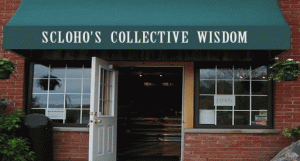
Last week this article from Mediapost arrived in my email which gives a few tips, especially when the buyers are age 50+:
People Make All Purchase Decisions
In a recent article, “All purchase decisions are made by people” Gavin Finn,CEO of Kaon Interactivewrote, “While data science and analytics have become an essential element of every modern marketing arsenal, it is wise to remember that people make all purchase decisions.”
He goes on to say, “Even in business purchases, the individual decision-makers are subject to the same strengths and weaknesses as consumers. Neuroscientists have proven that every decision has an element of emotion to it . . . In fact, many behavioral scientists believe that the primary decision drivers are mainly emotional.”
When marketing to Baby Boomer’s (52 to 70 years of age), focusing on product features and benefits often results in a losing strategy, especially early on in the process. As shown above, research has shown that consumers’ final decisions are not the direct product of the reasoning process; in fact, as we age emotions drive us even more in our purchase decisions. The reasoning process will confirm their decision, but it doesn’t start there.
Although all of us have basic human values and motivators that drive us, we manifest them differently as we move through the spring, summer, fall, and winter of life. Selling to Baby Boomer customers is different primarily because of this shift how we manifest values and motivators.
Our human need for identity, relationships, purpose, gaining knowledge and growth, rejuvenation and recreation are always with us. However, as we age, we focus more on having meaningful life experiences compared to our younger selves that concentrate on gaining material goods. As such, it’s in your best interest to determine and communicate how your brand, product or service provides a gateway to meaningful life experiences.
Sales professionals should begin a sales presentation by first developing a relationship.
1. Understand you’re in an emotionally charged environment and take the time to practice focused listening. Salespeople often speak to the customer in a very staccato fashion. They immediately start talking about their product/service’s features and benefits without trying to build the relationship first. This approach is not usually practical, because as we get older, we become more resistant to absolute guarantees or propositions than when we were younger.
2. Never rush the Boomer customer or patronize them. The older we get, we more easily recognize and the more we reject being patronized. Marketers and sales professionals should allow the consumer to pull wanted information; not push it at them.
3. Deliver objective information at a slow-to-moderate pace. Avoid jumping around on the issue. Maintain a steady equilibrium as you speak. Ask many open-ended questions that start the customer talking.
4. Be vulnerable, honest and open about who you are. The more honest you are, the better your chances are of developing a good solid bond in the relationship. Show sincere empathy and reduce your reliance on sales charts and other tools, and take more time to understand the Boomer’s needs and wants.
5. Saying less is more in many instances especially in the early stages of communicating. Let the consumer use his or her imagination to interpret your communications. Be prepared to provide more detail as requested.
Challenge your current sales approach and gain a better understanding of the physical as well as behavioral changes of aging consumers. Remember that as we age, we can’t hear, or taste or see as well, and if your sales approach, product information or environment isn’t user-friendly to these consumers; you’re often wasting your time.
The American historian Daniel J. Boorstin once said: “The greatest enemy of knowledge is not ignorance, it is the illusion of knowledge.” In other words, what stops you from knowing the truth is acknowledging a false truth as the truth. If you think you have the truth, but don’t, you stop seeking it. Keep seeking the truth.
by Scott Howard | Aug 4, 2016 | Marketing and Advertising Insights, ScLoHo Sales Tips, The Not-So-Secret Writings of ScLoHo
I just finished reading an article on Medium about Influencer Marketing that claims, For Every $1 Spent on Influencer Marketing, A Brand Makes $6.50.
But they are wrong.
I’m not doubting the facts and figures they present, but I doubt that the return is what they say it is.
It’s too low.
But it’s impossible to accurately measure despite the rise in data collection and technology that links our lives and behaviors, there is still a missing link and that missing link is the human factor which makes it impossible to accurately tell us which piece of the marketing puzzle was the final one that inspired us to buy.
Truth be told, there are countless influences on each individual buying choice we make.
So instead of telling you which is the best form of advertising and marketing, I’m going to challenge you in a different direction with the purpose of converting $1 into $10 with your marketing.
It boils down to what you do with a potential customer after they’ve heard/seen your ad. 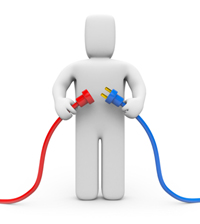
It’s about making the right connection with the follow through.
I’ll use an advertising partner of mine who will remain nameless today, but they are aware of what I’m going to share and I’m going to help them fix the problem.
This service oriented business was getting several phone calls from people that could have become customers but didn’t.
(I have access to some of their incoming phone calls and listened to a couple dozen of them recently.)
The service manager talked to a potential customer for 5 minutes without offering to schedule a service call to send a tech to diagnose the problem. Instead he gave the person calling advice on what the problem could be and left it hanging…
Another call from a potential customer who was ready to book a service call but the scheduler led her down a different. complex path and again it was a lost sale.
That’s just two calls that I heard where the professionals in the business had potential customers call them and the result was not good.
It wasn’t good for the people who called because when they hung up the phone there was no plan to fix the problem they called about.
It wasn’t good for my advertising partner because they spent time on the phone and lost money (for the time) instead of earning money (by converting the call into a customer.)
This is not an isolated incident.
I dropped my insurance agent a few years ago, because he didn’t offer a solution to a problem.
Even the fast food minimum wagers are trained to ask if you want to make that burger a full meal.
Your job as a business is to offer a solution to people who are asking for help.
Most people will pay you for that solution.
You spend money to invite those folks to contact you.
Now you need to follow through and with those people who walk in your store, call your office or connect online. Solve their problem, and they will pay you. They will also tell others about how well you took care of them.
You’ve already spent the money to get them to connect. Earn that money back and you can start seeing a 10 to 1 return on your advertising and marketing.
by Scott Howard | Jun 15, 2016 | Marketing and Advertising Insights, ScLoHo Sales Tips, ScLoHo's Web World, The Not-So-Secret Writings of ScLoHo
A co-worker asked me recently what I do to prospect. In other words, what do I do to find new advertising partners.
My answer is different than what I would recommend others do because each of us have different connections and personalities and there is no “one-size-fits-all”.
One thing all of us have in common, is we need to be inviting people to do business with us, and the methods we use should be relevant to us and our potential customers.
Last week I received an email that was both lazy and stupid.
Lazy because the person did absolutely nothing to qualify me for his service. And Stupid because, I now have a negative opinion of him and his company. Here, take a look:
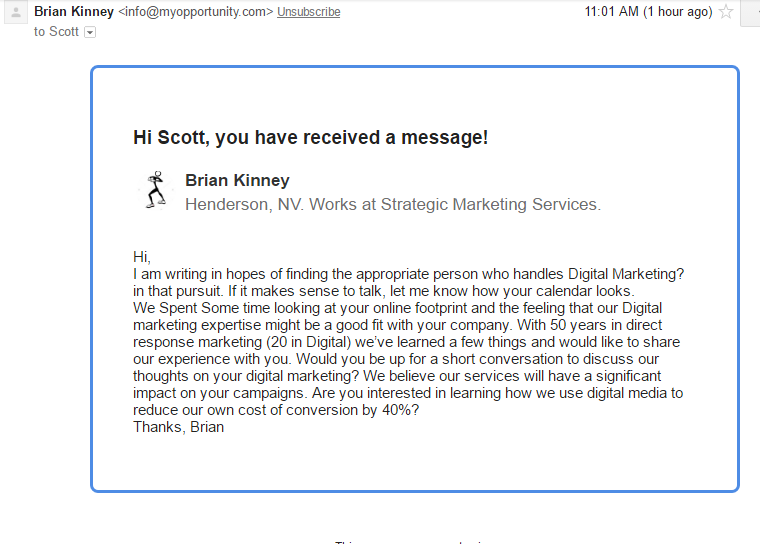
I use email as a communication tool. I use it as a prospecting tool. I never would send an email like Brian sent, and neither should you. I’d like your feedback on why this email is lazy and stupid, or perhaps you think it’s okay. Either way, leave a comment, I’d like to know your thoughts.
by Scott Howard | Jan 24, 2015 | ScLoHo Sales Tips
You can’t please everyone all the time. And you need to know what you can and cannot do. Check out this sales tip from RAB.com:
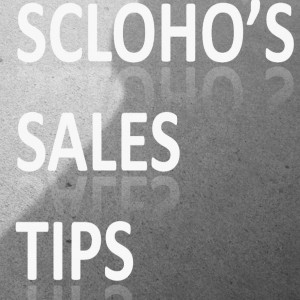
Don’t be bullied
Sales trainer/motivational coach Paul Cherry
Stand up to bullies, even when they’re your customers.
Some customers just don’t deserve your business; they end up costing you more in time and resources than they give back in business and profits.
If you have customers who are bullies, confront them. If you can’t win with the bully because they’re their own worst enemy, or because their values are so out of sync with your own, walk away and invest your time on customers who appreciate the value you can bring to them.
More from Paul can be found here: pbresults.com
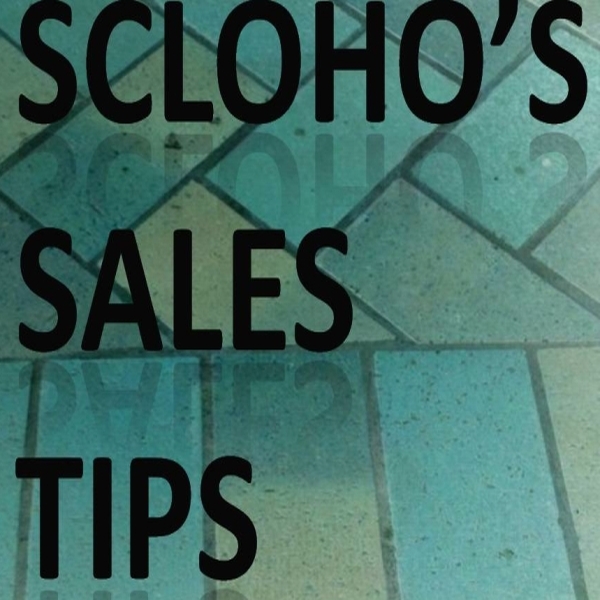
by Scott Howard | Jan 17, 2015 | ScLoHo Sales Tips
This sales tip originally posted in a RAB.com newsletter is old school. However like many things that people used to do, like send hand written thank you notes, they are even more effective now than 30 years ago because they are more unique.
This is about building credibility and using the phone:
The higher authority close
Sales consultant/trainer Tom Hopkins
A higher authority is a respected person known by your client who is willing to give third-party testimony. The higher authority will most often be a satisfied client — possibly the one who referred you to the prospective future client.
To set this close up, choose your higher authority and discuss the situation with them. Tell him or her that you’ll be meeting with “Jim Johnson” at 2:00 p.m. on Thursday, and ask if they might be available around 2:30 p.m. to take your telephone call in case you need his or her input. Always offer to refer other business back to your higher authority in exchange for their involvement or to return the favor.
When you make the call, simply make the connection, do a brief introduction, and then let your higher authority tell your prospective client how great your and your product/service are.
If your higher authority is unavailable to take your call, ask for a testimonial letter and permission to use his or her name.






